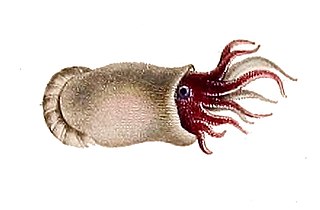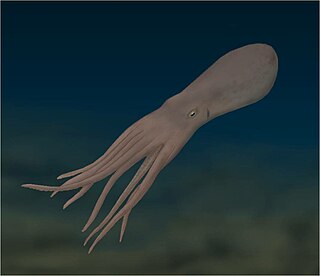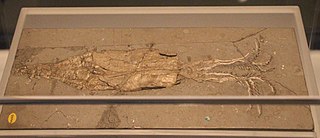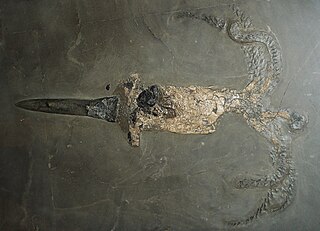
A cephalopod is any member of the molluscan class Cephalopoda such as a squid, octopus, cuttlefish, or nautilus. These exclusively marine animals are characterized by bilateral body symmetry, a prominent head, and a set of arms or tentacles modified from the primitive molluscan foot. Fishers sometimes call cephalopods "inkfish", referring to their common ability to squirt ink. The study of cephalopods is a branch of malacology known as teuthology.

Spirulida is an order of cephalopods comprising one extant species and several extinct taxa.

Coleoidea or Dibranchiata is one of the two subclasses of cephalopods containing all the various taxa popularly thought of as "soft-bodied" or "shell-less". Unlike its extant sister group Nautiloidea, whose members have a rigid outer shell for protection, the coleoids have at most an internal shell called cuttlebone or gladius that is used for buoyancy or as muscle anchorage. Some species, notably incirrate octopuses, have lost their internal shell altogether, while in some it has been replaced by a chitinous support structure.

Neocephalopods are a group of cephalopod mollusks that include the coleoids and all extinct species that are more closely related to extant coleoids than to the nautilus. In cladistic terms, it is the total group of Coleoidea. In contrast, the palcephalopoda are defined as the sister group to the neocephalopoda.

Palaeoctopodidae is an extinct family of incirrate octopuses that lived during the Late Cretaceous. It includes two genera, Keuppia and Palaeoctopus.

Belemnotheutis is an extinct coleoid cephalopod genus from the middle and upper Jurassic, related to but morphologically distinct from belemnites. Belemnotheutis fossils are some of the best preserved among coleoids. Remains of soft tissue are well-documented in some specimens, even down to microscopic muscle tissue. In 2008, a group of paleontologists even recovered viable ink from ink sacs found in several specimens.
The Allaru Formation, also known as the Allaru Mudstone, is a geological formation in Queensland, Australia, whose strata date back to the Early Cretaceous. Dinosaur remains are among the fossils that have been recovered from the formation.
Styletoctopus is an extinct genus of octopus. The genus consists of the single species Styletoctopus annae, which lived approximately 95 million years ago during the late Cenomanian,. It was first discovered in 2009 by a team led by Dirk Fuchs of Freie University in the Hâqel and Hjoula localities in Lebanon. Very few octopus species appear in the fossil record, as octopuses consist of soft tissue that usually decomposes before it has time to fossilize.

Keuppia is an extinct genus of octopus.

Belemnitida is an extinct order of squid-like cephalopods that existed from the Late Triassic to Late Cretaceous. Unlike squid, belemnites had an internal skeleton that made up the cone. The parts are, from the arms-most to the tip: the tongue-shaped pro-ostracum, the conical phragmocone, and the pointy guard. The calcitic guard is the most common belemnite remain. Belemnites, in life, are thought to have had 10 hooked arms and a pair of fins on the guard. The chitinous hooks were usually no bigger than 5 mm (0.20 in), though a belemnite could have had between 100 and 800 hooks in total, using them to stab and hold onto prey.

Dorateuthis is a genus of cephalopod with a gladius and soft-part anatomy preserved. Fossils of D. syriaca are found in Upper Santonian-aged shale of Late Cretaceous Lebanon.

Cirrate octopuses possess a well-developed internal shell that supports their muscular swimming fins. This is in contrast to the more familiar, finless, incirrate octopuses, in which the shell remnant is either present as a pair of stylets or absent altogether.
This list, 2013 in molluscan paleontology, is a list of new taxa of ammonites and other fossil cephalopods, as well as fossil gastropods, bivalves and other molluscs that have been described during the year 2013.

The Sannine Formation, also called the Sannine Limestone, is a Cretaceous geologic formation in Lebanon. It is a Konservat-Lagerstätte that contains a high diversity of well-preserved fish, reptiles, and invertebrates from the Tethys Ocean within its three main localities: Haqel, Hjoula, and Nammoura.

Mauriciosaurus is a genus of polycotylid plesiosaur from the Late Cretaceous of Mexico. It contains a single species, M. fernandezi, described in 2017 by Eberhard Frey and colleagues from a single well-preserved juvenile specimen about 1.9 metres long. Morphologically, it is overall most similar to the polycotyline polycotylids Trinacromerum and Dolichorhynchops. However, several features separate Mauriciosaurus from all other polycotylids, warranting the naming of a new genus. These include the sophisticated pattern of ridges on the bottom of the parasphenoid bone on its palate; the narrow openings in the palate bordered by the pterygoid bones; the lack of perforations in the surface of the coracoid; and the highly unusual arrangement of gastralia, or belly ribs, which is only otherwise seen in the non-polycotylid Cryptoclidus.
Boreopeltis is an extinct genus of plesioteuthidid cephalopod, with 4 known species.

Muensterelloidea is a superfamily of stem-octopod cephalopods from the Early Jurassic to Late Cretaceous. Two families are currently identified, Muensterellidae, and Patelloctopodidae. The clade is the ancestral group from which modern octopus arose.

Enchoteuthis is an extinct genus of large enchoteuthine cephalopod that lived during the Cretaceous. Although it and its relative Tusoteuthis are often compared to squid, both are now thought to be more closely related to modern octopuses. Examination of gladius remains initially yielded an estimated mantle length about 2 m based on specimen once described as Tusoteuthis longa, close to or equal to that of the modern giant squid, although reclassification of this genus as a muensterelloid results in a much shorter total length, about 3 m (10 ft). Three species are currently recognized as valid: E. melanae, E. tonii, and E. cobbani.
Eromangateuthis is an extinct genus of large plesioteuthidid cephalopod from the Cretaceous of Australia and possibly Canada.
Sahel Alma or Sahel Aalma is a Late Cretaceous paleontological site and Konservat-Lagerstätte in Keserwan-Jbeil, Lebanon. Located near the town of the same name, it documents well-preserved deepwater marine fossils dating to the late Santonian stage of the Cretaceous. It is often associated with the slightly older, similarly famous Sannine Formation sites, with these four sites being together referred to as the "Fish Beds" of Lebanon.














